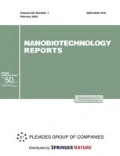We present the next thematic issue of the journal Nanobiotechnology Reports, dedicated to the currently very relevant area of research and development “Nanomaterials, components and computing systems for the implementation of neuromorphic principles of information processing and storage.”
The topic of using biosimilar principles for the construction of artificial computing and memory devices has relatively recently received a powerful impetus for development due to the experimental discovery in 2008 of a new component of electrophysical systems, the memristor. A memristor is an electrically rewritable memory cell with a resistive-switching threshold. In general, this element has a multidigit or even analog range of values of stored resistances, between which a smooth controlled transition is possible. In this sense, the memristor imitates the main property of biological interneuronal contacts (synapses), the so-called synaptic plasticity; therefore, it can be used to create hardware-in-the-loop neuromorphic complexes that demonstrate some of the key functions of the living nervous system.
The implementation of an array of memristors in a “crossbar” architecture, i.e., at the intersection of electrode buses (rows and columns), provides the ability not only to store addressable synaptic weights, but also computations directly in the device memory, on account of the physical summation of current signals weighted by the conductivity of memristor cells. This property, as well as the possibility of miniaturization of the memristor into the nanoscale region, provide the prospect of a fundamental (by 2–3 orders of magnitude) increase in the energy efficiency and performance of a neuromorphic processor built on the basis of memristors, even in comparison with existing and emerging specialized solutions for accelerating artificial-intelligence neural-network algorithms based on digital components only.
At the same time, despite the wide variety of known memristive materials and resistive-switching effects, a memristor element with characteristics suitable for industrial use in neuromorphic computing has not yet been found. The reasons are both in the complex, nonlinear nature of resistive switching, which depends, inter alia, on the stochasticity of microprocesses at the nanoscale, and in the mutual antagonism of the required properties, such as, for example, a long state-retention time and, at the same time, the smooth nature of resistive switching (plasticity), and in matters of compatibility with advanced technological processes of microelectronics.
On the other hand, the search for optimal algorithms for tuning (training) arrays of memristors, effective models of neuron-like elements, architectures of new methods of artificial intelligence, in particular based on pulsed neural networks, and much more, continues.
We have already come a long way in all these directions, effective memristor elements and neuromorphic systems have been demonstrated, but much remains to be done. This issue presents some of the key Russian work in this area. The contribution of Russian science today seems to be quite consistent with the world level. Nevertheless, the consolidation of efforts is required in this important branch of nature-like technologies, which promises a unique opportunity for the development of national security and responding to the great challenges of the Strategy of scientific and technological development of Russia.
Editor-in-Chief, Corresponding Member of the Russian Academy of Sciences, Professor M.V. Kovalchuk
Guest Editor of theIssue: Cand. (Phys.-Math.) Sci. V.A. Demin
Rights and permissions
About this article
Cite this article
Editorial. Nanotechnol Russia 16, 705 (2021). https://doi.org/10.1134/S2635167621060124
Published:
Issue Date:
DOI: https://doi.org/10.1134/S2635167621060124

